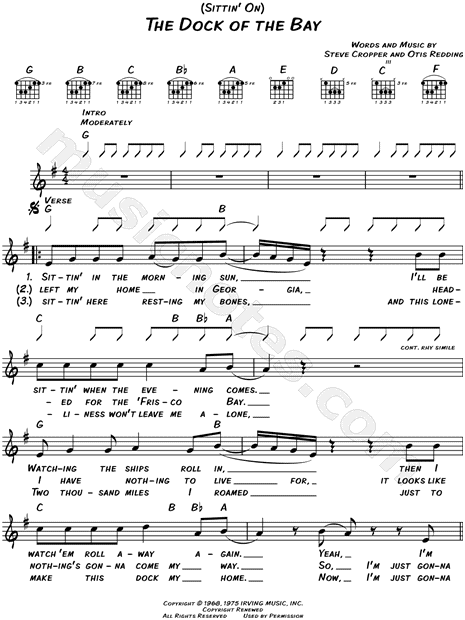

Redding didn’t have much more than the basic chords and his first verse about sitting and watching the ships, and the chorus. (Cropper says that years later Neil Young told him he stayed in Graham’s houseboat the week after Redding.) On the bright side, Cropper’s misunderstanding about the location led him to add the lines, “I left my home in Georgia, heading for the Frisco Bay,” which works much better than “heading for Richardson Bay,” where Redding and the dock were.

“Me being a purist kind of guy I said, ‘Otis, did you ever think that if a ship rolls it’s going to take on water and sink,'” Cropper recalls, “and he said about the lyric, ‘Hell, Crop, that’s what I want,’ and Otis always got his way.”Īctually, the Golden Gate Bridge isn’t even visible from where Redding was, but Cropper never saw that spot until years later when he was on tour with Robert Cray he got a bite to eat overlooking the water and saw ferries going back and forth and realized that “when a ferry goes to park it pushes up a big wake and comes in sideways and looks like it is rolling in.

The fact that Cropper wasn’t there is obvious in his reaction to the song – that fall, when Redding first sang him the lines “Watching the ships roll in/And then I watch ’em roll away again,” Cropper says he “always envisioned a ship going under the Golden Gate Bridge.” Redding’s Wikipedia page mistakenly claims that the song “was written with Cropper while they were staying with their friend, Earl ‘Speedo’ Simms, on a houseboat in Sausalito.” But while Simms, Redding’s road manager, was there, Cropper was thousands of miles away. But Redding was more than 10 miles away, at Waldo Point Harbor in Sausalito. Meanwhile, the city of San Francisco recently put the lyrics on display on a pier in Brannan Street Wharf. Marc Myers, in his book Anatomy of a Song: The Oral History of 45 Iconic Hits that Changed Rock, R&B and Pop, mistakenly noted that Redding went to the houseboat to catch his breath right after playing Monterey. It’s here where Redding began writing the song – and where the first of the myths and misconceptions about it began. When rock impresario Bill Graham made him an offer to get out of downtown, Redding, a country boy at heart, was happy to spend those days on Graham’s houseboat. Still, Redding was committed to the road for the rest of that summer, including a six-night gig at Basin Street West in San Francisco in August. “One of the main things Otis told me in the car one day was, ‘I’m coming to Memphis and I’m going to get a place and you and I are going to produce and write songs.’ He really enjoyed being in the studio.” “Absolutely his style was changing,” Cropper tells Rolling Stone. Redding had produced (and co-written) Arthur Conley’s hit “Sweet Soul Music” earlier that year and Cropper says he started talking about getting off the road and spending more time producing in the studio. He had always relied on the emotion and energy in his vocals to carry his songs, but now he started paying more mind to the words themselves he’d also recorded most of his songs live in the studio, but the complex layering achieved by the Beatles and George Martin clued him in to other ways of building tracks. Pepper’s Lonely Hearts Club Band over and over. Redding had begun listening to Bob Dylan, whom he’d met at the Whisky in ’66 but beginning in June, the singer – like the rest of the world – was playing Sgt. It was the only time I told Otis what to do.” I suggested he write something folk-like, saying we could call it Soul Folk. “He saw a huge crowd of white kids going nuts over him, and he began to believe he could follow in the footsteps of Sam Cooke and Ray Charles.”Īl Bell, then a Stax executive, says that he told Redding he was getting pegged as a genre musician and “would have to come up with something different.

“Monterey had a powerful effect on Otis,” recalls Stanley Booth, who interviewed Redding for the Saturday Evening Post during those final sessions.


 0 kommentar(er)
0 kommentar(er)
